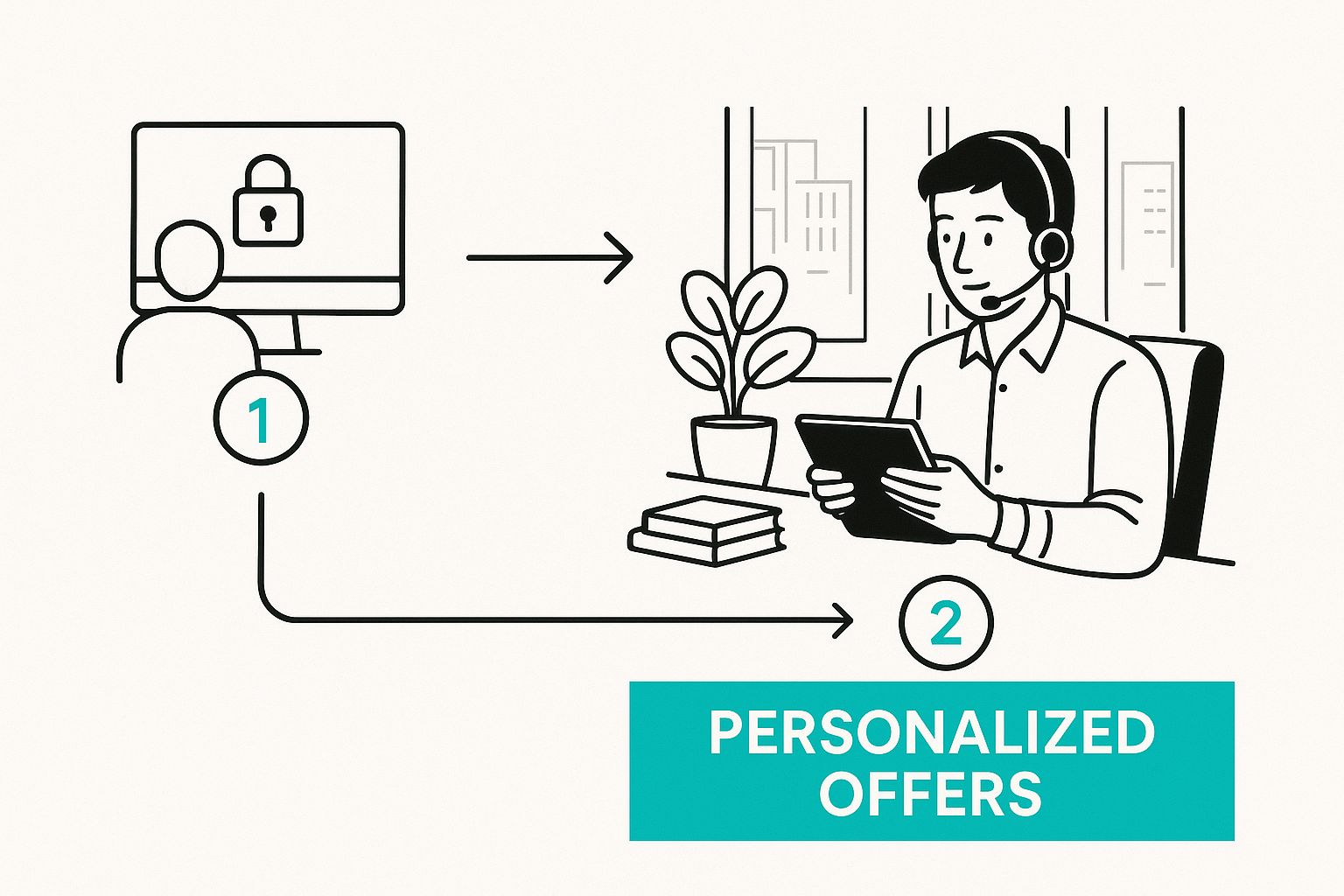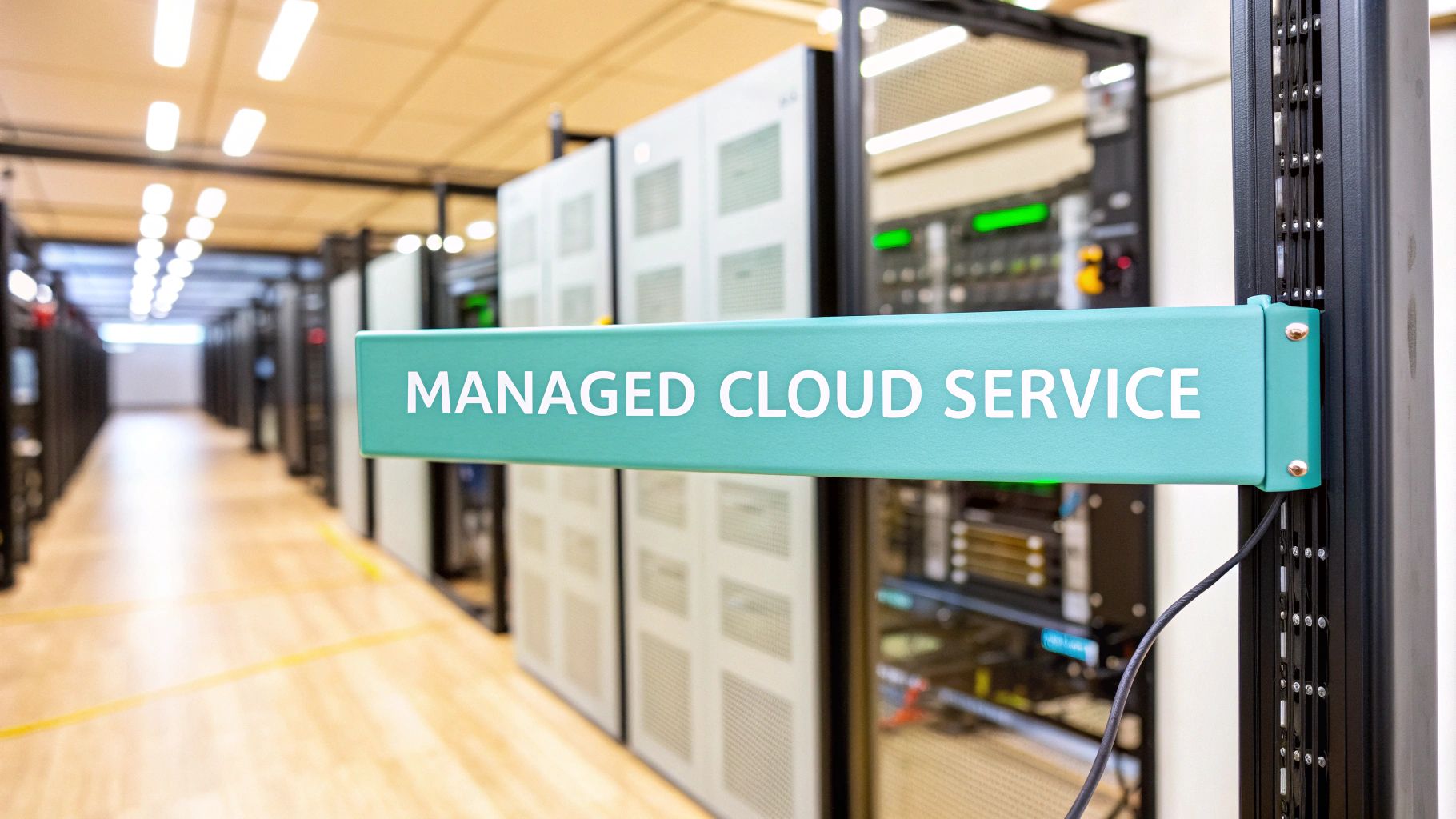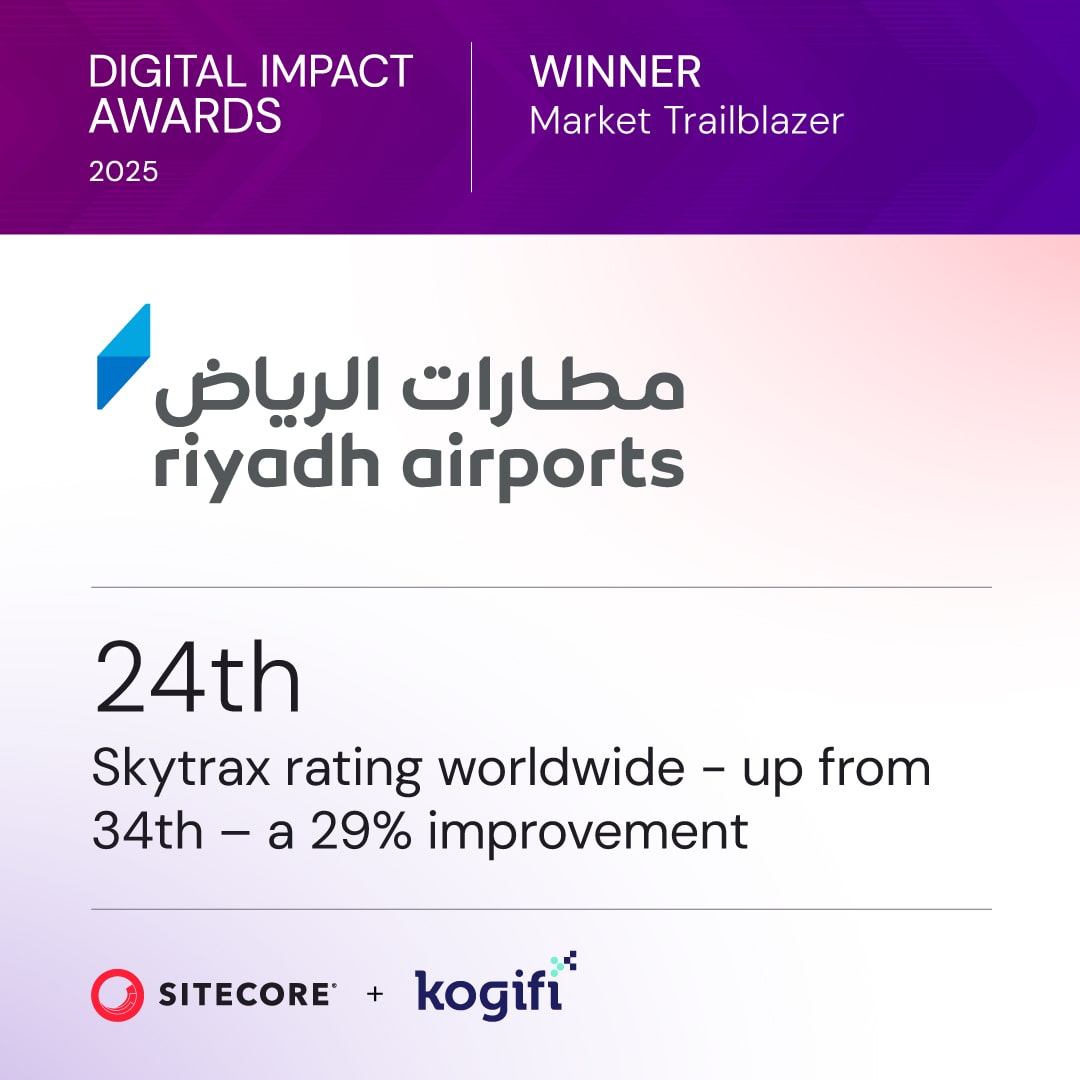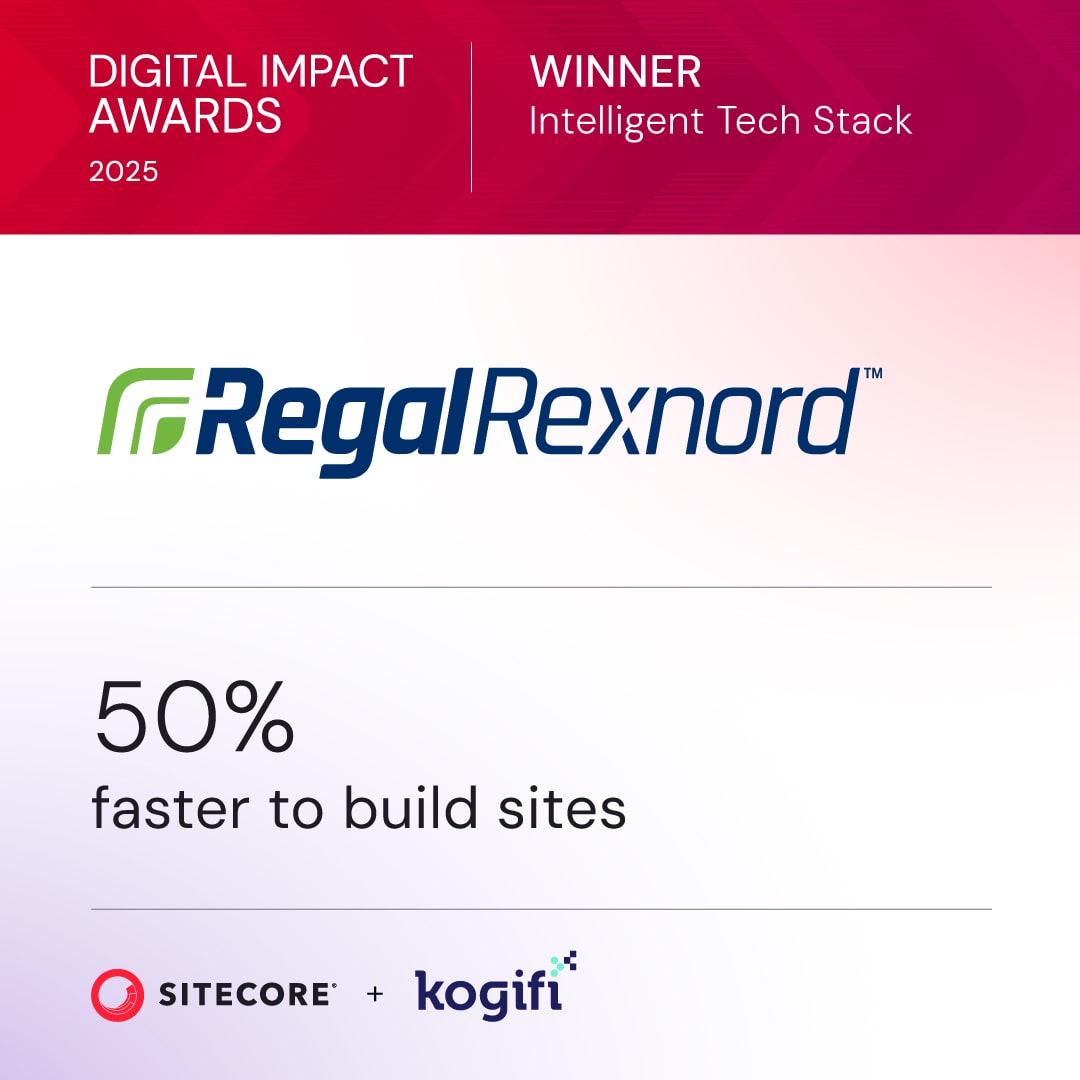Improving customer engagement is more than just closing a sale. It's about building an intelligent, unified conversation with your customers everywhere they interact with your brand. The secret? A composable Digital Experience Platform (DXP) like Sitecore that creates a connected ecosystem where your content, commerce, and customer data finally start working together.
Building a Foundation for Real Engagement
Before you can truly improve customer engagement, you have to get your tech foundation right. When your systems are disconnected, you create disjointed experiences. Customers get frustrated, and your marketing teams are left trying to make sense of incomplete data. A composable DXP, especially one from the Sitecore portfolio, gives you the framework to build that holistic customer view.
Instead of siloed tools for marketing, sales, and service, a DXP brings them all under one roof. This architecture lets you track a customer's entire journey—from their first visit to your site all the way to their most recent purchase and any support tickets they've filed. Suddenly, you can actually understand their behavior and start anticipating what they need next with surprising accuracy.
The Cost of Disengagement
If you don't build this unified view, the consequences are very real. Poor engagement isn't just a missed opportunity; it's a direct hit to your bottom line. The stakes are incredibly high, as many studies show that a majority of consumers would switch to a competitor after just a few bad interactions with a brand.
This really drives home the point: high-quality engagement is non-negotiable for customer retention and, frankly, business survival.
Core Sitecore Capabilities for Engagement
Sitecore’s product suite is engineered specifically to solve these kinds of problems. It’s a set of powerful, interconnected tools that form the bedrock of a modern engagement strategy.
To make sense of it all, here's a quick breakdown of the core Sitecore components that form the foundation for a sophisticated customer engagement strategy.
This foundational layer is what makes it possible to move from basic, transactional interactions to meaningful, data-driven relationships. It’s the prerequisite for the advanced personalization and omnichannel strategies we’ll dive into next.
Delivering Hyper-Personalized Customer Journeys
Let's be honest, generic content is a dead end. If you want to improve customer engagement, you have to make people feel like you genuinely get them. This means delivering hyper-relevant experiences at scale, which is exactly what Sitecore's Customer Data Platform (CDP) was built for. Think of it as the central brain for all your customer interactions, moving you far beyond surface-level personalization.
The magic starts by unifying customer data from every possible source. We're talking web analytics, mobile app usage, CRM information, and even offline interactions from your point-of-sale systems. Sitecore CDP pulls all this information together to build a single, rich profile for each customer, giving you a true 360-degree view of their behavior and preferences.
From Data to Dynamic Experiences
Once you have this unified profile, the real work begins. You can start building sophisticated segments based on complex behavioral patterns, not just simple demographics. For instance, instead of targeting "all returning visitors," you can create a segment for "visitors who viewed product category X more than three times in the last week but haven't purchased."
This is where you can trigger real-time personalization that actually resonates. Imagine a returning visitor being greeted with a hero banner that dynamically changes based on their last browsing session. Or an e-commerce site showing tailored product recommendations not just on the homepage but also within the checkout process. These are the contextual interactions that drive real engagement.
This infographic shows just how a customer support agent can use a unified data profile to provide personalized offers in real-time.

The key takeaway? When your teams have access to consolidated customer data, they can create immediate, relevant experiences at any touchpoint.
Practical Steps for Implementation
Of course, this isn't just about technology; it's about strategy. Here are a few practical ways to use Sitecore CDP to boost engagement:
- Behavioral Triggers: Set up automated triggers that respond to specific user actions. For example, if a user abandons their cart, you can automatically send an email featuring the exact items they left behind, maybe with a small incentive to complete the purchase.
- Content A/B Testing: Use the detailed segments in Sitecore CDP to run highly specific A/B tests. You can test different headlines, images, or calls-to-action on different audience groups to see what truly performs best, ensuring you're always optimizing.
- Next Best Action: Go beyond simple personalization by predicting a customer's next move. Sitecore's capabilities can analyze a user's journey and suggest the "next best action"—whether that’s recommending a relevant article, a product, or prompting them to sign up for a webinar.
The core principle is to use data to serve the customer, not just to sell to them. When every interaction is relevant and timely, you build trust and loyalty, which are the cornerstones of lasting engagement.
By adopting this approach, you transform your website from a static brochure into a dynamic, one-on-one conversation with each visitor. For a deeper dive into the mechanics and strategies behind this, you can learn more about the fundamentals of personalization on the web in our detailed guide. It’s all about moving from guesswork to data-driven precision.
Crafting Seamless Omnichannel Experiences

Here's something we've all learned: customers don't see channels. They see one brand. Whether they’re on your website, scrolling through the mobile app, or tapping a kiosk in a store, they expect everything to just work together. Any hiccup or disconnect between those touchpoints breaks the illusion and can kill engagement in an instant.
This is exactly where a headless architecture, particularly with a platform like Sitecore XM Cloud, becomes more than just a technical choice—it's a strategic one. A headless CMS works by separating the front-end presentation layer (the "head") from the back-end content hub. This simple but powerful split lets you manage all your content in one central place and push it out to any device or platform through APIs.
Think of it as a "create once, publish everywhere" strategy. Your team can draft a new product announcement or a promotional offer just one time, and that single piece of content can be delivered seamlessly to your website, mobile app, email newsletters, and even digital displays in your physical stores.
The Real Advantage of Going Headless
The biggest win here is brand consistency. When everything flows from a single source of truth, you slash the risk of outdated or conflicting information showing up on different channels. This consistency is what builds trust and reinforces your brand identity at every single interaction.
It also makes your internal teams far more efficient. They're no longer stuck in a loop of creating and managing content separately for every channel. This frees up their time to focus on the bigger picture—crafting better content and strategy instead of getting buried in repetitive tasks.
Imagine a typical customer journey: someone starts researching a new product on their laptop at home. Later, on their commute, they open your mobile app and get a personalized notification that picks up right where they left off. That's the kind of seamless experience that a unified content and data strategy makes possible.
When your content and personalization rules are managed centrally, you can build intelligent journeys that flow effortlessly between touchpoints. This elevates the customer experience from a series of isolated interactions into a single, continuous conversation with your brand.
To pull this off, you need to really understand the principles of connecting with customers everywhere they are. For a deeper dive, check out our complete guide on what is omnichannel marketing. The goal is to make every channel work in harmony, creating an experience that feels both intuitive and deeply personal.
Using AI to Predict and Enhance Engagement
Artificial intelligence is no longer just some far-off concept; it’s a practical, powerful tool you can use right now to seriously improve customer engagement. In the Sitecore ecosystem, AI isn't a tacked-on feature—it's woven into the core of the platform to analyze customer behavior, figure out what they’ll do next, and automatically deliver experiences that just work.
This shifts your entire strategy from being reactive to predictive.
Instead of guessing which content might resonate, AI-powered features do the heavy lifting. They churn through thousands of data points in real-time, spotting patterns you'd never catch on your own. Think about what that means: you can identify customers who are about to leave, pinpoint high-value prospects, and serve up the perfect next step for every single person.
Automated Optimization and Content Intelligence
One of the most immediate ways to see AI in action is with testing and optimization. Old-school A/B testing is fine, but it’s slow and pretty limited. Sitecore’s AI automates this, constantly testing different layouts, headlines, and images to discover the winning combination for specific audience segments.
This is where a tool like Sitecore Discover, an AI-powered search and merchandising tool, really proves its worth. It taps into behavioral data to show each visitor the most relevant products and content.
The interface here shows just how AI can create individualized commerce experiences. From predictive search to personalized recommendations, it turns a simple search bar into an engine for engagement.
AI is also a workhorse behind the scenes. It can automatically tag new content and images, making everything easier for your team to find and manage. This frees up your content creators from getting bogged down in repetitive tasks so they can focus on big-picture strategy.
The real magic of AI here is its ability to learn and adapt. The system gets smarter with every single interaction, constantly refining its predictions and optimizations to boost engagement over time.
The Growing Role of AI in Engagement
The move toward AI-driven engagement isn't just a trend; it's quickly becoming the standard. A significant percentage of organizations are either using AI in their customer engagement stack or have plans to. It’s also estimated that AI will be involved in the vast majority of all customer interactions worldwide in the near future, which just goes to show how effective it is at delivering hyper-relevant interactions at scale.
At the end of the day, integrating AI is about making your team better, not replacing it. For anyone looking to bring these advanced features on board, having a solid strategy is non-negotiable. You can check out our guide on AI personalization in DXP implementation for a roadmap to get started. By using AI to anticipate user needs and automate personalization, you can build the kind of smart, responsive experiences that create lasting customer loyalty.
Powering Engagement with SharePoint Integration

Exceptional customer engagement on the front end is almost always the result of smooth, efficient operations on the back end. Think about it: when your customer-facing teams are scrambling for the right information or working with outdated documents, that friction inevitably trickles down to the customer experience.
This is exactly where integrating a powerful collaboration tool like SharePoint with your Sitecore DXP becomes a game-changer. By connecting SharePoint’s top-tier document management and team collaboration features, you create a single source of truth for your internal teams. It’s a simple concept with a huge impact.
This integration streamlines content workflows, making sure everyone from marketing to sales and support has instant access to the most accurate, up-to-date information. The result is a more informed, efficient team that delivers consistent messaging and better support.
Unifying Internal and External Knowledge
One of the biggest wins from this integration is bridging the gap between your internal knowledge base and your customer-facing content. For example, all that technical product documentation that often lives buried in a SharePoint library? That's a goldmine of valuable information for your customers.
Instead of the old-school, error-prone method of manually copying this data, an integration allows you to sync it directly to your Sitecore product pages. This automates the whole process, slashes the risk of human error, and guarantees that when a spec sheet gets updated internally, it's immediately reflected on your website. It’s a practical, direct way to improve customer engagement by providing reliable, timely information they can trust.
The core idea here is to eliminate content silos. When your DXP can pull information directly from your internal collaboration hub, you empower your teams, slash content duplication, and ultimately create a far more consistent and trustworthy customer experience.
Practical Integration Use Cases
Beyond just syncing documents, this combination unlocks several powerful scenarios that have a direct impact on engagement. Let's look at some real-world examples I've seen in action:
- Unified Knowledge Base: Imagine creating a single repository of articles and guides in SharePoint that serves two purposes. It can be the go-to resource for your internal support agents while also populating the customer-facing FAQ or help center on your Sitecore site. One update, two audiences covered.
- Streamlined Asset Management: Marketing teams can use SharePoint to manage and approve campaign assets like images, videos, and PDFs. Once an asset gets the green light, it can automatically appear in the Sitecore media library, dramatically speeding up content creation.
- Sales Enablement: Your sales team can access the latest case studies, datasheets, and presentations stored in SharePoint directly through a portal built on Sitecore. This ensures they always have the correct, most compelling materials right when they're interacting with prospects.
By connecting these two platforms, you’re not just linking software; you’re building an ecosystem that supports both your employees and your customers more effectively.
To see how this powerful tool can fit into your operations, you can learn more about our approach to SharePoint solutions and how they can build a stronger foundation for your digital strategy.
How to Measure and Optimize Your Strategy
Improving customer engagement isn't a one-and-done task. It’s a constant loop of measuring what's working, learning from the data, and refining your approach. Without the right metrics, you’re essentially flying blind, making decisions based on gut feelings instead of what your customers are actually telling you.
This is where the analytics baked into the Sitecore ecosystem really shine. It’s time to look past surface-level "vanity metrics" like page views or session duration. These numbers might look good on a report, but they tell you very little about genuine interest or intent. Instead, the real goal is to track metrics that directly tie back to customer value.
Moving Beyond Vanity Metrics
Inside Sitecore Experience Platform (XP), the secret weapon is the Engagement Value (EV) score. Think of it as a powerful, customizable metric you assign to the critical actions a user takes on your site.
For instance, a newsletter signup might be worth 10 points, downloading a whitepaper could be 25 points, and requesting a demo—a high-intent action—could be worth 100 points.
By tracking EV, you get a much sharper picture of how people are actually interacting with your content and moving through their journey. It helps you pinpoint which pages, campaigns, or personalization rules are driving valuable behavior, not just clicks. This gives you a direct line of sight into the ROI of all your engagement efforts.
The goal is to create a feedback loop. The insights you gather from your analytics should be used to directly refine your personalization rules, A/B tests, and content strategy for measurable improvement.
A Framework for Continuous Optimization
A data-driven optimization process is the engine that keeps your engagement growing. It’s all about creating a systematic way to test, learn, and evolve your strategies based on what real users are doing.
Here’s a practical framework you can put into action using Sitecore’s tools:
Set Meaningful Goals: Before you test a single thing, you need to define what success actually looks like. Use Sitecore’s goal-tracking feature to create specific conversion points, like "Completed Contact Form" or "Added Product to Cart," and assign each one an EV.
Run Targeted A/B Tests: Don't guess—test. Use Sitecore’s built-in A/B and multivariate testing to validate your ideas. Go beyond just testing button colors. Pit entire component variations against each other, test a personalized banner against a generic one, or try out different calls-to-action for specific audience segments.
Analyze Path and Behavior Flow: Dive into the Path Analyzer in Sitecore to see the most common journeys customers take on your site. This is a goldmine for spotting friction points where users drop off and identifying opportunities to smooth out the path toward your most valuable goals.
This continuous loop ensures you're always making decisions backed by data, not assumptions. It turns your DXP from a simple content library into a dynamic growth engine that’s constantly learning and adapting to improve how you connect with your customers.
Frequently Asked Questions
When you start digging into improving customer engagement with a DXP, plenty of questions pop up. This is especially true when you're looking at connecting powerful platforms like Sitecore and SharePoint. Let's tackle some of the most common ones.
How Quickly Can I See Engagement Results?
While the big, foundational changes obviously take time, you can get some early wins pretty quickly.
For instance, you could launch a simple personalization rule in Sitecore Experience Platform (XP)—something like showing a unique banner to returning visitors. You could see a measurable lift in click-through rates from a small change like that in just a few weeks. More advanced strategies, like an AI-driven journey optimization, will naturally take a few months to show their full ROI as the system collects and learns from more data. The trick is to start small with high-impact tweaks and build momentum from there.
What Is the Main Benefit of SharePoint Integration?
In a nutshell, it’s all about content consistency and operational efficiency.
When you integrate SharePoint, you create a single source of truth for all your internal documents, product specs, and other critical assets. This simple connection wipes out version control headaches and ensures the information pushed to your customer-facing Sitecore site is always the most current, accurate version. That consistency is a huge factor in building and maintaining customer trust.
How Can I Measure Engagement on Social Channels?
To get the full story on how your engagement efforts are paying off, you need to look beyond your DXP. While Sitecore does a great job tracking on-site behavior, you'll want to dive into specific Social Media Engagement Metrics to see what's happening on other platforms. This external data completes the picture, giving you a holistic view of your brand's interaction quality everywhere.
The most important thing to remember is that true engagement isn't about a single campaign; it's about building a connected ecosystem. Both Sitecore and SharePoint provide the tools to create a seamless flow of information between your internal teams and external audiences, which is the foundation of any successful strategy.
Ready to build a truly connected and engaging digital experience? The experts at Kogifi can design a powerful DXP solution using Sitecore and SharePoint to meet your unique business goals. Get in touch with us today!








































